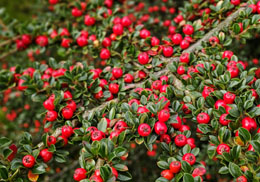Very popular for landscaping, cotoneaster plants require a little bit of care, for a healthy growth. This article provides some tips for growing contoneasters.

There are different types of cotoneasters, that are commonly used for landscaping. You can find various species as shrubs, ground covers, and big plants. These woody plants belong to the genus
Cotoneaster in the family
Rosaceae (rose family). Around 300 species of cotoneaster plants have been identified, and the most interesting fact is that most of these plants are distinctly dissimilar.
While most of them are shrubs, which include both upright and ground hugging ones; there are some small trees too. Cotoneaster plants can be either deciduous or evergreen. Deciduous ones produce attractive flowers during late spring and early summer. However, it is not for the flowers, that these plants are grown, but for the brightly colored berries and the fall foliage.
Popular Cotoneasters
The most popular species is
Cotoneaster horizontalis, which is mainly grown in rock gardens. As the name rightly suggests, this plant grows horizontally. The stems are stiff and dense, and they grow in herringbone pattern. The small round leaves turn red during the fall. During late spring, light pink-colored flowers are produced by this plant, and these blooms develop dark red berries.
Cotoneaster dammeri is a ground cover plant, which is usually grown on walls and slopes. This plant blooms during late spring and the fragrant, white flowers develop to form red berries in autumn.
Cotoneaster acutifolius is a tall plant with dark green leaves, that turn red during autumn, and black berries. This is one of the popular hedging plants. Other species that are useful as hedge plants are
Cotoneaster apiculatus and
Cotoneaster divaricatus. These plants too produce red berries in clusters.
Cotoneaster Plant Care
These plants can thrive in a wide range of growing conditions. However, a little bit of care is required for their healthy growth and maintenance. The minimum requirements for these plants are full sun and moist, well-drained soil. Add some peat moss to the soil, which is meant for planting cotoneasters. You have to feed the plant twice every month with a water-soluble plant food, till it blooms. After that, use fertilizers every month during the growing season, until the color of the leaves begins to change with the onset of autumn.
Pruning can be done anytime, and this is beneficial for keeping the plant in shape; and for removing the dead branches and those parts, that are affected by fire blight. Fire blight can be controlled by using sprays with fixed copper during the flowering season. Cotoneasters should not be planted near orchard apple trees, so as to avoid fire blight. It is also important to remove the suckers produced from the roots of the plant, on a regular basis.
In short, these plants can be an attractive addition to your garden, as they produce beautiful flower clusters and brilliantly colored berries, apart from the autumn foliage.






 There are different types of cotoneasters, that are commonly used for landscaping. You can find various species as shrubs, ground covers, and big plants. These woody plants belong to the genus Cotoneaster in the family Rosaceae (rose family). Around 300 species of cotoneaster plants have been identified, and the most interesting fact is that most of these plants are distinctly dissimilar.
There are different types of cotoneasters, that are commonly used for landscaping. You can find various species as shrubs, ground covers, and big plants. These woody plants belong to the genus Cotoneaster in the family Rosaceae (rose family). Around 300 species of cotoneaster plants have been identified, and the most interesting fact is that most of these plants are distinctly dissimilar.